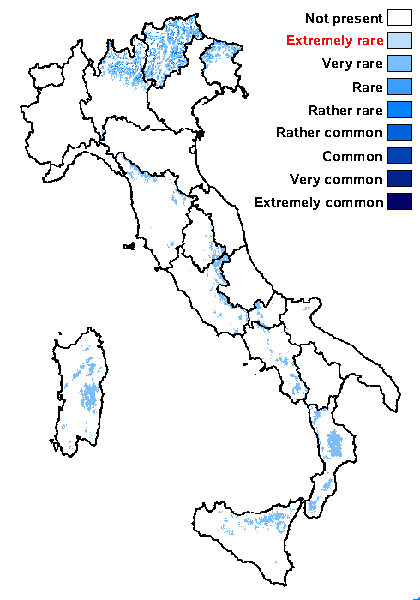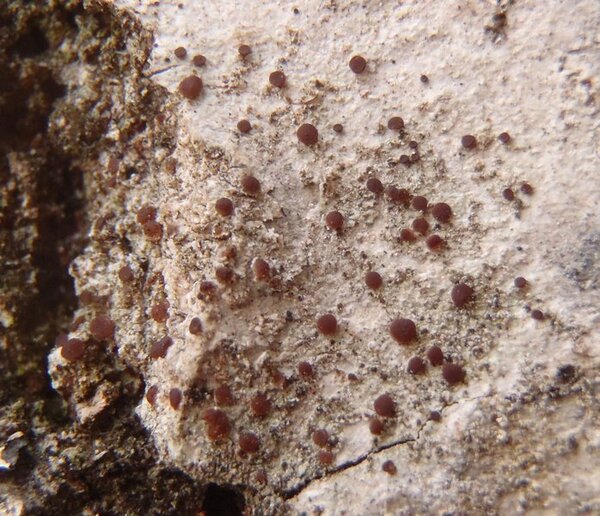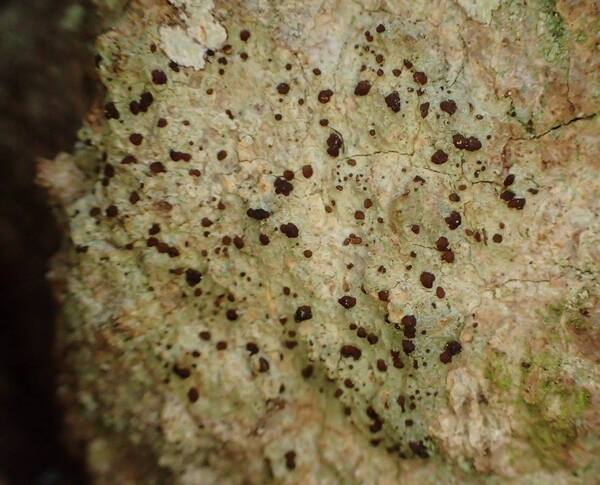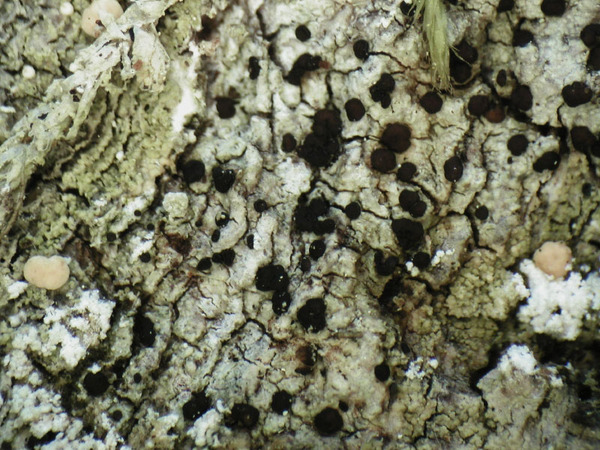Lecidea erythrophaea Sommerf.
Flörke ex Sommerf., Suppl. Fl. Lapp.: 163, 1826.
Synonyms: Biatora alnicola Anzi; Biatora erythrophaea (Sommerf.) Fr.; Lecidea alnicola (Anzi) Jatta; Lecidea cupuliformis (Räsänen) H. Magn.?; Lecidea hyalinella (Körb.) Jatta; Lecidea minuta (Schaer.) A. Massal.; Lecidea tenebricosa auct.
Distribution: N - Frl, TAA (Nascimbene & al. 2007b), Lomb. C - Tosc (Printzen 1995), Umb (Ravera & al. 2006, 2006b), Laz (Ravera 2006, 2006c), Mol (Ravera & Genovesi 2012), Sar (Zedda 2002, 2002b, Cossu 2013). S - Camp (Brunialti & al. 2013, Ravera & Brunialti 2013), Pugl, Cal (Puntillo 1996), Si (Grillo & Cristaudo 1995, Grillo 1998, Grillo & Caniglia 2004).
Description: Thallus crustose, endosubstratic or thinly episubstratic, continuous to rimose, pale grey or greenish grey. Medullary hyphae I-. Apothecia biatorine, rounded to slightly irregular in outline, rarely tuberculate, adnate to sessile and constricted at base, 0.25-0.7(-1) mm across, with a ochre to reddish brown (in older apothecia sometimes almost black), flat to slightly convex disc and a concolorous or usually slightly darker, soon excluded proper margin. Proper exciple pale brown in outer part, colourless or with small pigmented droplets within, 25-60 µm wide laterally, 35-85 µm wide at base, of radiating hyphae with swollen end cells; epithecium reddish brown, 5-10 µm high, K-; hymenium colourless to pale yellowish brown, 35-55(-70) µm high, I+ blue; paraphyses simple or sparingly branched and anastomosing, 0.7-2 µm thick at mid-level, the apical cells 2.5-5 µm wide, with a brown cap; hypothecium colourless or very pale brown, 45-125(-170) µm high. Asci 8-spored, distinctly thickened at the apex, with a I+ blue tholus, the outer gelatinous coat I+ pale blue, approaching the Bacidia-type. Ascospores 1-celled, hyaline, fusiform, (7-)9-15(-18) x 3-4(-5) µm. Photobiont chlorococcoid. Spot tests: thallus K-, C-, KC-, P-, UV-. Chemistry: without lichen substances.Note: a mainly boreal-montane, probably circumpolar species of acid bark, especially of conifers, in humid-cold situations, e.g. in Sphagnum bogs, which apparently reaches Sicily along the Apennines (Sicilian records, however, need re-confirmation). Closely related to L. rhododendri and certainly not a Lecidea s.str. It is easily confused with Japewiella tavaresiana, which has larger, thick-walled ascospores.
Growth form: Crustose
Substrata: bark
Photobiont: green algae other than Trentepohlia
Reproductive strategy: mainly sexual
Commonnes-rarity: (info)
Alpine belt: absent
Subalpine belt: rather rare
Oromediterranean belt: absent
Montane belt: very rare
Submediterranean belt: absent
Padanian area: absent
Humid submediterranean belt: absent
Humid mediterranean belt: absent
Dry mediterranean belt: absent

Predictive model
Herbarium samples
Growth form: Crustose
Substrata: bark
Photobiont: green algae other than Trentepohlia
Reproductive strategy: mainly sexual
Commonnes-rarity: (info)
Alpine belt: absent
Subalpine belt: rather rare
Oromediterranean belt: absent
Montane belt: very rare
Submediterranean belt: absent
Padanian area: absent
Humid submediterranean belt: absent
Humid mediterranean belt: absent
Dry mediterranean belt: absent

Predictive model
| Herbarium samples |
 INDEX FUNGORUM
INDEX FUNGORUM
 GBIF
GBIF
 DOLICHENS
DOLICHENS





